#upadana
Photo


These tags by @clonecumber on this post about Jedi reminded me of something about the concept of “attachment” in Buddhism that might be interesting and helpful for thinking about it in Star Wars, especially with regard to Anakin.
So, for the Buddhist concept, the word that’s being translated in English as “attachment” is upadana. The literal meaning of upadana in the Pali language is “fuel,” but in an abstract sense you’ll see it translated as “clinging” or “grasping.”
Buddhism says that there’s a set of factors that goes into how a person experiences and interacts with the world, or part of how they construct their identity and the idea of ‘self.’ In Pali this is kandha and translated with words like “aggregate” or “bundle,” coming from the sense of a bundle of stems/branches or the trunk as the union/aggregate of all branches of a tree.
There are five of these aggregates/kandhas. One kind of kandha is physical, sensual things. If you think of material wealth as a bundle of branches, being greedy and clinging to/grasping for it is like pouring gasoline over the wood and throwing down a match, creating fire (suffering) when you steal from people, exploit them, etc. Each factor/kandha is something that upadana--clinging or attachment--is directed towards, and eliminating attachment/clinging/upadana is part of how you can stop creating suffering.
Material things are the only purely physical kandha. The others include emotions (where fear gets a special mention), states of mind, and even things like how you view yourself and what you believe about the world. When Yoda talks about how fear leads to anger, anger leads to hate, and hate leads to suffering, he’s echoing the idea that fear of loss and change in a world where the nature of things is to constantly change is what spurs people to cling to things, to form attachments.
When Anakin’s mom is kidnapped and beaten by Tuskens, he’s ultimately unable to save her and must confront a very sharp, painful loss. His worst fear from his nightmare has been realized. Instead of reaching out and trying to process/deal with his grief and pain in a healthy way, he lets anger get the better of him and he massacres all the Tuskens in the encampment. All he’s done is spread suffering and murder. This does nothing to help his mother, the Lars family, or victims of literally any party of ongoing land/water disputes on Tatooine. Everything that happened here was purely about Anakin and his impulse to take revenge, jumping down the fear->anger->hate->suffering train like a slip-n-slide.
Anakin routinely has a really hard time undercutting his own upadana, his grasping at and attachment to things that must and will change, must pass. Whenever Obi-wan tells him to “be mindful of [his] feelings,” he doesn’t mean that Anakin just needs to check himself and do some introspection whenever he’s angry or feeling a negative emotion. He’s reminding Anakin that he needs to do some consideration and introspection for all feelings, negative and positive, to think about the relationship between kandhas and upadana.
Anakin doesn’t need to learn that anger and hate are bad. He needs to learn that even positive things like love can be the objects of attachment/upadana, and that’s the clinging demonstrated in his inability to accept death and loss--however shocking and painful--as a natural process, setting him down Yoda’s cycle of fear, anger, hate, and suffering, unable to walk way.
#Not to compare Shmi dying to Clonecumber's big dog example but the part where Clonecumber says it's all about YOUR feelings#rather than the dog's welfare is the same thing I was going for when I talked about Anakin's reaction to Shmi dying#It's 100% about Anakin's feelings and it doesn't benefit anybody#I also want to say that Buddhism is over two thousand years old and there is over two thousand years worth of philosophical development#and commentary stretching across multiple countries and contexts#Other traditions also have a concept of upadana and they're also quite old and philosophically diverse#with different ways of analyzing upadana#I absolutely cannot do justice to that and I'm not the person to talk about that but I just wanted to say#that people have been thinking about what we call 'attachment' for a very long time and have had many and varied thoughts about it#I know the Jedi aren't 1:1 analogues of any one real world philosophy/religion/path but this is all still useful IMO#The Force reminds me of Brahman but I'm pretty sure that concept is fundamentally not compatible with a Buddhist view of things#star wars meta#jedi#star wars#jedi positivity#anakin skywalker#anakin#upadana
48 notes
·
View notes
Text
ROUND 2, Part 8

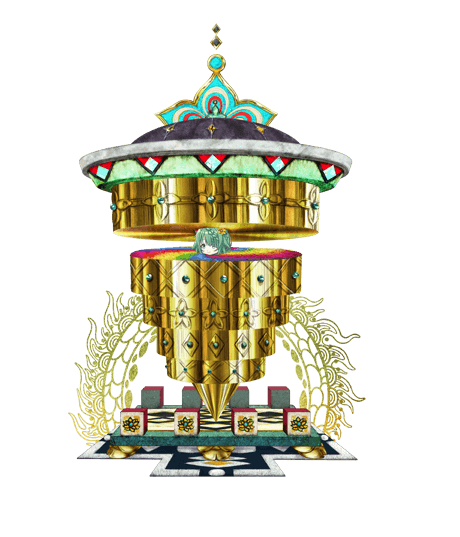


7 notes
·
View notes
Note
13 :)
Question from here
13. Were the Jedi right or wrong to ban attachments? What constitutes an attachment?
SO GLAD YOU ASKED
Attachment, as the word is used in Star Wars, is an attempt to translate the Buddhist idea of upadana. I… don't think it's a good one — I would have used rapacity personally — but uh, points for effort I guess.
More than anything else, it's specifically and explicitly a cause of suffering.
It's not love, not in any positive connotation of the word. It's coveting. It's greed. It's wanting to possess someone, not caring what their feelings are on the matter. Not letting them go, even if they beg. It's needing the next hit of a drug to function, even if you hate what the drug does to you, hate the person you become under the influence.
@gffa has an excellent post on attachment as we see it in the core lore (movies, TCW, word of god etc) if you want further explanation/examples.
So, back to the original question: are the Jedi right to ban attachments? (An aside: they don't ban it, they're not the church, but we'll ignore that for now.)
The Jedi are magical space wizards, with the power to cause mass destruction. They choose not to, because they've grown up understanding that they must be responsible, and live harmoniously with the world around them. This keeps both them and their society safe(r).
Do I think people with built-in abilities to raze cities should be controlled by greed and fear? No, actually. I think that's a terrible idea. We had one darksider with Jedi-level powers completely destroy democracy in what was once the Republic after plunging the entire known universe into a years-long war. One. There are 10,000 trained Jedi Knights.
I don't want to even imagine that universe.
(All opinions expressed above are solely those of pass e. ridae and do not express the views or opinions of any affiliates or associates, passerine or otherwise)
#dae asks#star wars#attachment#I have ongoing umbrage with Lucas' choice of translation there#such is life
97 notes
·
View notes
Text
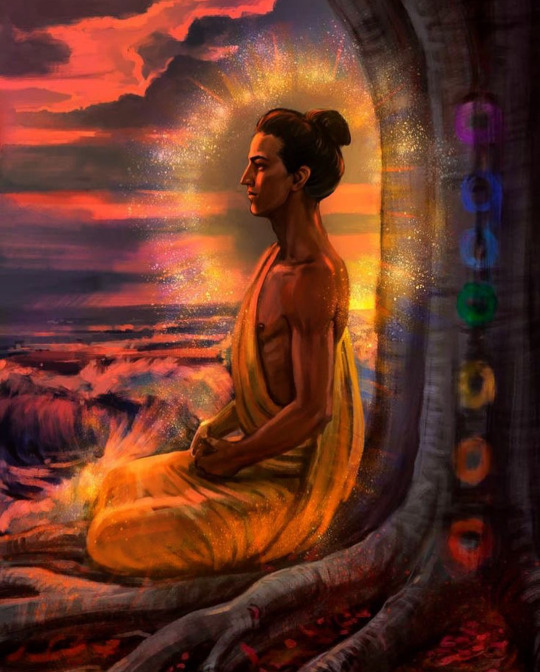
Paccaya Sutta: Discourse
on Dependent Arising - 04
"Clinging, monks, is conditioned by craving. Whether there is the arising of the Buddha or not, this property exists, this regularity of things, this order of things, this specific conditionality. The Buddha awakens to this realisation.
Having awakened to it and realised it, the Buddha tells, teaches, describes, establishes, reveals, analyses and clarifies saying, look, clinging is conditioned by craving".
[Clinging or grasping can be considered as an intensified form of craving. The literal meaning of the Pali term upadana, is fuel. Within the process of dependent arising, clinging fuels the next link of becoming. There are four types of clinging: clinging to pleasurable sensual experiences (kamupadana), clinging to wrong views (ditthupadana), clinging to rules and rituals believing that they will bring one's liberation (silabbatupadana) and clinging to the belief of a self (atta-vadupadana).]
"Craving, monks, is conditioned by feeling. Whether there is the arising of the Buddha or not, this property exists, this regularity of things, this order of things, this specific conditionality. The Buddha awakens to this realisation.
Having awakened to it and realised it, the Buddha tells, teaches, describes, establishes, reveals, analyses and clarifies saying, look, craving is conditioned by feeling".
[Craving (tanha) is divided into six classes based on the sense base and the particular sense object from which feeling arose and caused the arising of craving: craving for forms through the eyes (rupa tanha), craving for sounds through the ears (sadda tanha), craving for smells through the nose (gandha tanha), craving for tastes through the tongue (rasa tanha), craving for touch through the body (potthabba tanha) and craving for mental objects through the mind (dhamma tanha) .]
4 notes
·
View notes
Photo
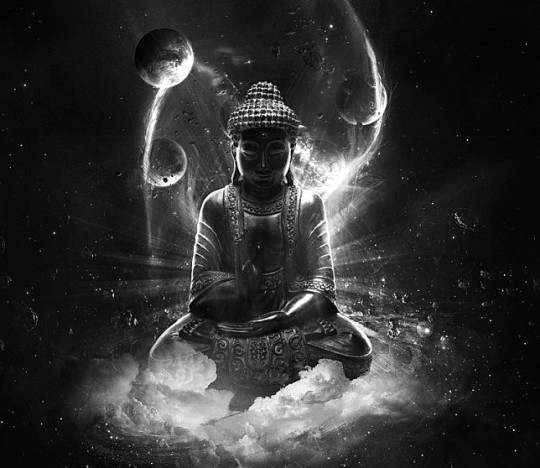
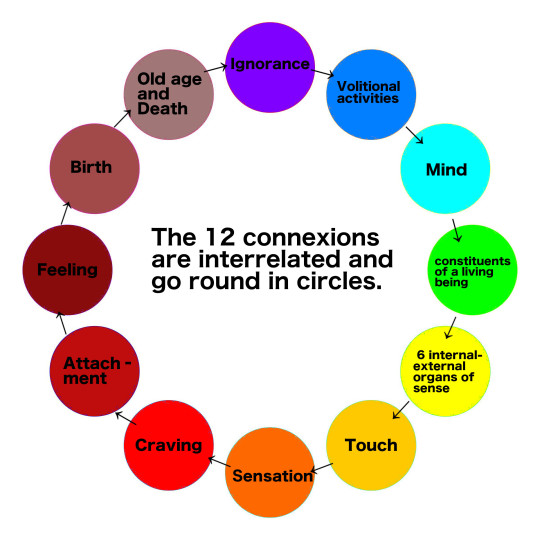
The Quest for Buddhism (58)
Pratityasamutpada – the 12 links of conditioned arising - Part 3
From 7 to 12 causal branches continued as follows [See: 1 -6]:
7. Sensation – vedana is a Buddhist term referring to the sensing action of humans. It is the feeling of touch. The six senses come into contact with the six external sense organs through the six internal sense organs and sense them. Besides physical and physiological sensations such as 'hot' and 'painful', including those that are perceptually felt by the mind, such as suffering and pleasure. For example, feeling 'beautiful' when looking at nature.
8. Craving – trsna (tanha) is an important concept in Buddhism, referring to "thirst, desire, longing, greed", either physical or mental. The sanskrit word “trsna” is typically translated as craving, and is of three types: "craving for sensual pleasures", "craving for existence", and "craving for non-existence".Trsna is also mentioned in the 4 Sacred Truths, which state that it is the cause of suffering and that this causes living beings to repeat death and rebirth in the wheel of samsara.
9. Attachment– upadana means "fuel, material cause, substrate that is the source and means for keeping an active process energised". It is also an important Buddhist concept referring to "attachment, clinging, grasping". It is considered to be the result of trsna (craving), and is part of the dukkha (suffering, pain) dogma in Buddhism.
10. Feeling – bhava is the state of existence of a living being, the area of survival. It refers to the state in which sentient beings go through ‘trailokya’ in the cycle of samsara (reincarnation). Trailokya stands for the three realms that are the world of greed, the world of pure matter, free from desire(colour), and the world that transcends both desire and material conditions and dwells only in mental action (colourlessness).
11. Birth – Jati refers to the repeated existence of a person as a new life through samsara (reincarnation).
12. Old age and Death – Jaramarana stands for "old age" (jara) and "death" (marana). In Buddhism, jaramarana is associated with the inevitable decay and death-related suffering of all beings prior to their rebirth within samsara (cyclic existence).
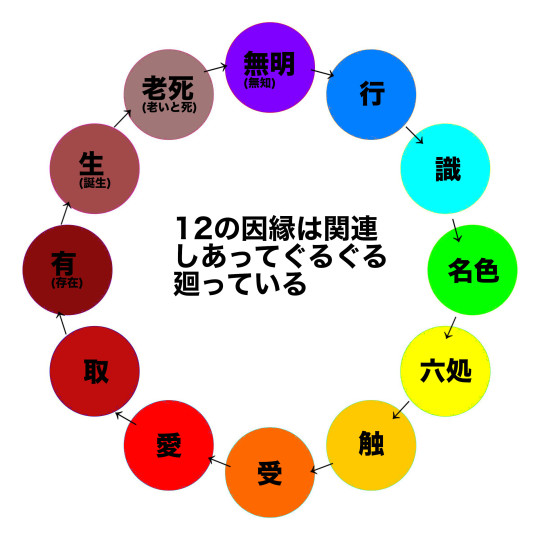
仏教の探求 (58)
十二因縁 (じゅうにいんねん、梵: プラティチャサムトパーダ)・その3
七〜十二の支分は以下の通りに続く(参照: 1〜6):
7. 受 (じゅ、巴・梵: ヴェーダナー)とは、人間の感受作用を意味す��仏教用語。触れたことを感じることである。六識が六根を通じ六境に接触し、まずそれを感受すること。肉体的、生理的に感じる「暑い」「痛い」などの感じの他にも、「苦しい」「快い」などの、心で知覚的に感じるものも含んでいる。例えば、自然を見て「美しい」と感じること。
8. 渇愛 (かつあい、梵: トリシュナー、巴: ターナー)は仏教における重要な概念で、肉体的または精神的な「渇き、欲望、あこがれ、貪欲」を意味する。サンスクリット語の「トリシュナー」は、通常、渇愛と訳され、「官能的快楽への渇愛」、「存在への渇愛」、「非存在への渇愛」の3種類がある。さらに渇愛は四諦 (したい、梵: チャトゥル・アーリヤ・サティヤ、4つの聖なる真理の意)にも記されており、それは苦の原因であり、これによって生けるものは輪廻の輪において死と再生を繰り返すとしている。
9. 取 (しゅ、梵・巴: ウパーダーナ)とは「燃料、物質的な原因、活動的なプロセスを活気づける源や手段である基質」を意味する。 また「執着、しがみつき、把握」を指す重要な仏教概念であり、トリシュナー (渇愛)の結果と考えられ、仏教のダッカ(苦痛) の教義の一部となっている。
10. 有 (う、梵: バーバ)とは、とは、生きものの生存状態、生存領域。三界を衆生が輪廻していく状態を指す。三界とは「欲望の世界(欲界)」「欲望を離れた清浄な物質の世界(色界)」そして「欲望も物質的条件も超越し、ただ精神作用にのみ住む世界(無色界)」の三つの世界のこと。
11. 生(しょう、梵:ジャーティ)とは、サンサーラによって新しい生命として、繰り返し存在しつづけることを指す (輪廻転生)。
12. 老死 (ろうし、梵:ジャラマラナ)とは、ジャラマラナとは「老い(ジャラ)」と「死(マラナ)」のこと。すべての生き物がサンサーラ(循環する存在)の中で生まれ変わる前に避けられない衰えと死に関連する苦しみのこと。
#pratityasamutpada#dvadasangika-pratityasamutpada#buddhism#buddha#reincarnation#samsara#the 12 nidānas#12 causal branches#nirvana#philosophy#nature#art#karma
149 notes
·
View notes
Text
Theory about Gojo's rebirth and enlightenment.
Gojo was inspired by Buddha so on the day he turns 29, he will embark on the path to enlightenment. But this is his path to continue.
Maybe starting from the moment Gojo was born, he had to become enlightened. Shakyamuni (Buddha)'s enlightenment anniversary is celebrated on December 8 in Japan. This means that after 1 day of birth, Gojo became enlightened.
As for Gojo's journey to enlightenment, it may be that of Engaku (縁覚): self-enlightened one. Because he is always associated with 独(alone) or just one person (1人), he became enlightened alone a long time ago.
Engaku is the journey of enlightenment upon realizing Juni-innen (十二因縁:twelve nidanas). The rule is one producing another.
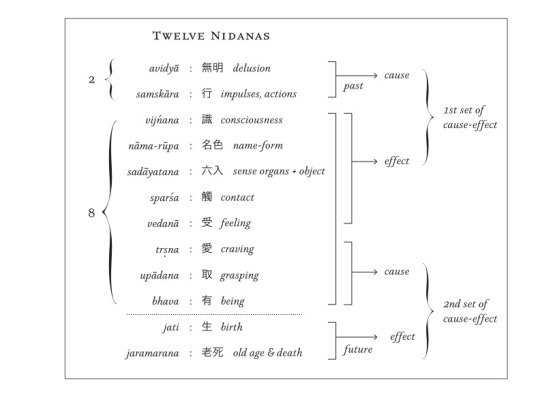
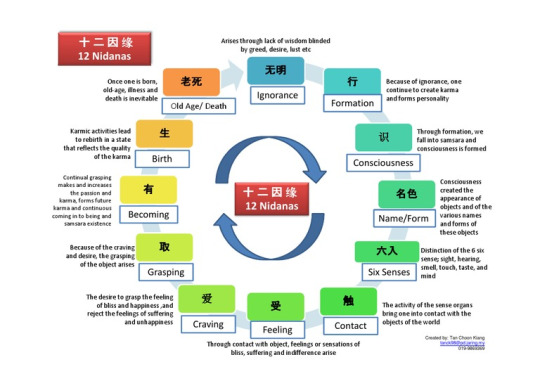
The stage to pay attention to is the starting chapter of Gojo with the theme 愛. It doesn't necessarily mean love. In the twelve nidanas, 愛(tanha) refers to desire. With Gojo's desire to be understood when having ultimate power, his loneliness as the only one strongest.

The word 愛 -> 取(upadana): clinging, attachment. This makes sense for holding on to the sense of wanting to understand his ultimate power through training students to be stronger.
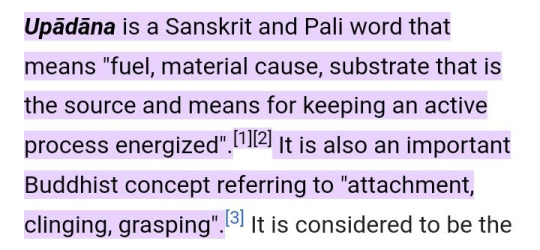
And when fighting Sukuna, 取-> 有(bhava): existence, being, has the meaning of recognizing Gojo's existence when he has ultimate power. So he felt 愛: the desire to fight, to be understood with his ultimate power because Sukuna.

愛,取,有: the three causes that will lead to future effects are 生 (jati) for rebirth and 老死( jaramarana) for old age and death. There must be rebirth and then death and old age. If Gojo wants to achieve complete enlightenment, he must go through it


Gojo's present death could be the beginning of his rebirth and continued journey to full enlightenment.
Celebrating Bodhi Day is December 8 according to the lunar calendar and January 18, 2024 according to the solar calendar.
3 notes
·
View notes
Text

Sometimes we just keep pulling
-The Teachings of Ajahn Chah
"Trying to end suffering without first understanding the cause is like pulling on a rope that's stuck. You just pull the end of the rope over here. The other end of the rope is still stuck over there so it never comes. What to do to make it come? It does not come free because you never seek out the source, the root. You just get lost in pulling on this end. What is it stuck on? It must be stuck on something, and that's why it doesn't come. Go to the source, untie the knot, and be free."
Our shenpa (clinging & attachment) sometimes keeps pulling at us, so we continue to tug at getting what we want. When we don't get what we want we become frustrated and sometimes angry. Letting go of the rope is not always the answer. However, if we realize that we are literally pulling at ourselves, this way and that, it might be a good idea to find out what is causing us to become stuck.
Pulling at a rope that is stubbornly stuck at one end, kind of like pulling at an extension cord only to discover that it has become stuck on something at the other end, is annoying. Our own annoyance is the fuel (upadana) that keeps us tugging and tugging at the same thing.
Maybe you are trying to get someone to see things the way you see them or to accept a belief that you have, but stubbornly will not. Perhaps they are tugging at their own rope (shenpa). As Pema teaches, you feel that sticky feeling and you get more frustrated. Alternatively you could notice the sticky (annoying) feeling and allow a little slack in the rope. Better yet, make it fun. See if you can identify what the "sticky" feeling is and where it comes from. Doing this, in essence, allows you to undo the knot and let yourself flow--kind of like undoing a knot in your garden hose.
In the Sutta Pitika, the Buddha taught that there are these types of clinging:
1. **sense-pleasure (clinging to taste, touch, smells, and emotions)** clinging (*kamupadana*)
1. **all views** **(opinions)** clinging (*ditthupadana*)
1. **rites-and-rituals (traditions)** clinging (*silabbatupadana*)
1. **self-doctrine (beliefs)** clinging (*attavadupadana*).
The Abhidhamma provides the following definitions for these four clinging types:
1. **sense-pleasure clinging**: *repeated* craving of worldly things.
1. **view clinging**: *repeated *craving of our opinions/beliefs
1. **rites-and-rituals clinging**: *repeatedly *believing that rites alone could directly lead to liberation, such as chanting, singing bowls, chimes, etc.
1. **self-doctrine clinging**: *repeated *self-identification with one's own beliefs, points of view, etc.
19 notes
·
View notes
Text
Hartzeer dagboek
Oke deh , apakah aku harus menggabungkan metode Buddha dan kristen kembali 😓? Hemmh suatu cara lama yang pernah aku lakukan sih, singkat cerita aku mengalami sesuatu yang tidak menyenangkan yang sebenarnya membuatku dendam dan jengkel , hingga akhirnya aku teringat kembali bahwa ya aku pernah membaca ajaran buddha , istrinya pakddha , hahahahahha
Ajaran yang pernah membuatku kagum ketika aku berada di persimpangan iman , bagaimana tidak jika aku boleh jujur aku menderita ,menderita karena mengingat suatu masa lalu dan menderita karena kemelekatan kepada sesuatu tentang teman ,
Mungkin bisa kugambarkan dengan sajak berbahasa belanda ini
Hartzeer is een onzichtbare pijn
ik ben egoïstisch ,Ze moeten me vinden
Ik ben dicht bij ze geweest
Ze zouden het moeten onthouden
Maar alleen ik herinner het me
En ze vergaten het
Begitulah , apa yang menyebabkan penderitaan ini ? , Iyaa , yaitu Upadana
Upadana
Upadana adalah kemelekatan , aku terpaksa harus berkata bahwa ajaran buddha memiliki penjelasan yang rinci tentang hal ini
Paṭiccasamuppāda atau Kemunculan Ketergantungan ,Paṭiccasamuppāda secara sederhana tertuang dalam kalimat:
imasmiṃ sati idaṃ hoti
Dengan adanya ini, maka ada itu.
imassuppādā idaṃ uppajjati
Dengan timbulnya ini maka timbullah itu.
imasmiṃ asati idaṃ na hoti
Dengan tidak adanya ini maka tidak ada itu.
imassa nirodhā idaṃ nirujjhati.
Dengan terhentinya ini, maka terhentilah itu.
Begitulah , kemelekatan adalah awal dari penderitaan tapi hal tersebut ya masih asumsiku tentang sebuah sakit hati aaahh , sudahlah , aku campur aja catatanku
Vandaag kwam ik naar de tentoonstelling en ontmoette haar- 10 Juli 2023
4 notes
·
View notes
Text
Dependent Origination GPT
The "Twelve Links of Dependent Origination" (Paticca-samuppada) is a fundamental teaching in Buddhism that explains how suffering arises due to the interplay of different factors. The twelve links are:
Ignorance (Avijja) - refers to not understanding the Four Noble Truths and the true nature of reality.
Volitional Formations (Sankhara) - refers to the mental and physical actions that are conditioned by ignorance.
Consciousness (Vinnana) - refers to the awareness of an object or experience.
Name-and-Form (Nama-rupa) - refers to the physical and mental components of existence.
Six Sense Bases (Salayatana) - refers to the six sense organs (eyes, ears, nose, tongue, body, and mind) and their corresponding objects.
Contact (Phassa) - refers to the interaction between the six sense bases and their corresponding objects.
Feeling (Vedana) - refers to the pleasant, unpleasant, or neutral sensation that arises in response to contact.
Craving (Tanha) - refers to the desire or attachment to a particular feeling or experience.
Clinging (Upadana) - refers to the attachment or grasping at something.
Becoming (Bhava) - refers to the process of taking birth in a particular realm of existence.
Birth (Jati) - refers to the physical process of being born into a particular realm of existence.
Aging and Death (Jara-Marana) - refers to the inevitable process of growing old and the eventual cessation of life.
Each of these links is dependent on the previous one and leads to the next one, creating a cycle that perpetuates suffering. Understanding these links is
What is ignorance in dependent origination?
In Buddhist teachings, Dependent Origination is the principle that all things arise in dependence upon other things and conditions. It states that the arising of any phenomenon is the result of a complex interplay of causes and conditions. Ignorance (Avijja in Pali) is considered to be the root cause of all suffering and is the first link in the chain of Dependent Origination.
Ignorance refers to not understanding the true nature of reality, and the Four Noble Truths, which are the foundation of Buddhist teaching. It is a fundamental misunderstanding of the nature of self and the world, and it leads to the development of wrong views and the arising of craving and clinging.
Ignorance is often described as a state of confusion or not seeing things as they truly are. It is the lack of knowledge and understanding of the three marks of existence: impermanence, suffering, and non-self. Ignorance leads to the formation of wrong views and a sense of self, which in turn leads to attachment, craving, and clinging. These in turn give rise to the cycle of birth, aging, and death, which is the source of all suffering.
In summary, ignorance in dependent origination refers to not understanding the true nature of reality, which leads to the arising of wrong views, craving, clinging, and ultimately suffering. The elimination of ignorance is considered to be the key to breaking the cycle of suffering and achieving enlightenment.
And what are formations in dependent origination?
In the Buddhist teaching of Dependent Origination, formations (Sankhara in Pali) refer to the mental and physical processes that shape our experiences and give rise to our perceptions of the world. They are the second link in the chain of Dependent Origination.
Formations refer to the mental and physical processes that shape our experiences, including our thoughts, emotions, and actions. They include both wholesome and unwholesome mental states, such as love, compassion, anger, and hatred. Formations are influenced by our past experiences and conditioning, and they are the result of the interaction between the six sense bases (sight, sound, smell, taste, touch, and thought), and the six sense objects (forms, sounds, smells, tastes, tactile objects, and ideas).
Formations arise out of the previous link of dependent origination, ignorance (Avijja) and give rise to the next link, consciousness (Vinnana). They are responsible for shaping our perceptions of the world, including our thoughts, emotions, and actions. Formations are considered to be the driving force behind our behavior and the way we interact with the world.
In summary, formations in dependent origination refers to the mental and physical processes that shape our experiences and give rise to our perceptions of the world. They are the result of past experiences and conditioning and are influenced by the interaction between the six sense bases and the six sense objects. Understanding the nature of formations and how they shape our experiences is an important step in breaking the cycle of suffering and achieving enlightenment.
And what is consciousness in dependent origination?
In the Buddhist teaching of Dependent Origination, consciousness (Vinnana in Pali) refers to the mental state that arises in response to an object or a perception. It is the third link in the chain of Dependent Origination.
Consciousness is the mental state that arises in response to an object or perception and it's the process of being aware of something. It is the result of the interaction between the six sense bases (sight, sound, smell, taste, touch, and thought) and the six sense objects (forms, sounds, smells, tastes, tactile objects, and ideas). Consciousness is considered to be the bridge between the external world and the mind. It arises out of the previous link of dependent origination, formations (Sankhara) and give rise to the next link, name and form (Nama-rupa).
Consciousness is not considered to be a permanent entity, but rather a fleeting and constantly changing mental state. It is conditioned by past experiences and is influenced by the state of the mind, which is shaped by formations.
In summary, consciousness in dependent origination refers to the mental state that arises in response to an object or a perception, it is the result of the interaction between the six sense bases and the six sense objects, it arises out of formations and give rise to name and form. Understanding the nature of consciousness and how it arises and interacts with the world is an important step in breaking the cycle of suffering and achieving enlightenment.
And what is name-and-form in dependent origination?
In the Buddhist teaching of Dependent Origination, name-and-form (Nama-rupa in Pali) refers to the physical and mental components that make up an individual being. It is the fourth link in the chain of Dependent Origination.
Name refers to the mental aspect of an individual, including thoughts, emotions, and consciousness. Form refers to the physical aspect, including the body and its sense organs. Together, name and form make up the entirety of an individual being.
Name-and-form arises out of the previous link, consciousness (Vinnana) and gives rise to the next link, the six sense bases (Satta Ayatana). The six sense bases include the sense organs of sight, hearing, smell, taste, touch, and thought, which allow an individual to interact with the external world.
Name-and-form is considered to be the foundation of individual existence and is shaped by past experiences and conditioning. It is the basis of the sense of self and the way in which an individual experiences the world.
In summary, Name-and-form in dependent origination refers to the physical and mental components that make up an individual being, it arises out of consciousness and gives rise to the six sense bases, which allow the individual to interact with the external world. Understanding the nature of name-and-form and how it shapes individual existence is an important step in breaking the cycle of suffering and achieving enlightenment.
And what are the six sense bases in dependent origination?
In the Buddhist teaching of Dependent Origination, the six sense bases (Satta Ayatana in Pali) refer to the six senses (sight, sound, smell, taste, touch, and thought) that allow an individual to interact with the external world. It is the fifth link in the chain of Dependent Origination.
The six sense bases include the physical organs of sight, hearing, smell, taste, and touch, as well as the mental faculty of thought. They are the means by which an individual experiences the external world and are closely related to the process of consciousness.
The six sense bases arise out of the previous link, name-and-form (Nama-rupa) and give rise to the next link, contact (Phassa). Contact refers to the interaction between the six sense bases and the six sense objects (forms, sounds, smells, tastes, tactile objects, and ideas) which leads to the arising of sensations and feelings.
The six sense bases are considered to be the foundation of individual existence and the way in which an individual experiences the world. They are shaped by past experiences and conditioning and are closely related to the process of consciousness.
In summary, the six sense bases (Satta Ayatana) in dependent origination refers to the six senses that allow an individual to interact with the external world, they arise out of name-and-form and give rise to contact, which leads to the arising of sensations and feelings. Understanding the nature of the six sense bases and how they shape the individual's experiences is an important step in breaking the cycle of suffering and achieving enlightenment.
And what is contact in dependent origination?
In the Buddhist teaching of Dependent Origination, contact (Phassa in Pali) refers to the interaction between the six sense bases (sight, sound, smell, taste, touch, and thought) and the six sense objects (forms, sounds, smells, tastes, tactile objects, and ideas). It is the sixth link in the chain of Dependent Origination.
Contact refers to the point of interaction between the six sense bases and the six sense objects, which leads to the arising of sensations and feelings. It is the process by which an individual experiences the external world through the senses and it's the result of the six sense bases and the six sense objects coming together.
Contact arises out of the previous link, the six sense bases (Satta Ayatana) and gives rise to the next link, feeling (Vedana). Feeling refers to the pleasant, unpleasant, or neutral sensation that arises in response to contact. It is the subjective experience of the sense objects.
Contact is considered to be an important step in the process of perception and the arising of sensations and feelings. It is shaped by past experiences and conditioning and is closely related to the process of consciousness.
In summary, contact (Phassa) in dependent origination refers to the interaction between the six sense bases and the six sense objects, which leads to the arising of sensations and feelings. It arises out of the six sense bases and gives rise to feeling. Understanding the nature of contact and how it shapes the individual's experiences is an important step in breaking the cycle of suffering and achieving enlightenment.
And what is feeling in dependent origination?
In the Buddhist teaching of Dependent Origination, feeling (Vedana in Pali) refers to the pleasant, unpleasant, or neutral sensation that arises in response to contact between the six sense bases (sight, sound, smell, taste, touch, and thought) and the six sense objects (forms, sounds, smells, tastes, tactile objects, and ideas). It is the seventh link in the chain of Dependent Origination.
Feeling refers to the subjective experience of the sense objects, it can be pleasant, unpleasant or neutral. It is the result of the interaction between the six sense bases and the six sense objects and it arises out of contact (Phassa). Feeling is considered to be an important step in the process of perception and the arising of sensations and emotions.
Feeling arises out of contact and gives rise to the next link, craving (Tanha). Craving refers to the desire or attachment to a particular feeling or experience. It is the mental state that leads to clinging and the desire for continued existence.
Feeling is considered to be an important step in the process of perception and the arising of sensations and emotions. It is shaped by past experiences and conditioning and is closely related to the process of consciousness.
In summary, feeling (Vedana) in dependent origination refers to the pleasant, unpleasant, or neutral sensation that arises in response to contact between the six sense bases and the six sense objects. It arises out of contact and gives rise to craving. Understanding the nature of feeling and how it shapes the individual's experiences is an important step in breaking the cycle of suffering and achieving enlightenment.
And what is craving in dependent origination?
In the Buddhist teaching of Dependent Origination, craving (Tanha in Pali) refers to the desire or attachment to a particular feeling or experience. It is the eighth link in the chain of Dependent Origination.
Craving refers to the mental state of wanting or desiring a particular experience or feeling. It can manifest as a desire for pleasurable experiences, a desire to avoid unpleasant experiences, or a desire for continued existence. Craving is the source of clinging, which leads to the desire for continued existence and the cycle of birth, aging, and death.
Craving arises out of the previous link, feeling (Vedana) and gives rise to the next link, clinging (Upadana). Clinging refers to the attachment or grasping at something, it can manifest as attachment to physical objects, people, or ideas.
Craving is considered to be a major source of suffering and an obstacle to achieving enlightenment. It is shaped by past experiences and conditioning, and it is closely related to the process of consciousness.
In summary, craving (Tanha) in dependent origination refers to the desire or attachment to a particular feeling or experience. It arises out of feeling and gives rise to clinging. Understanding the nature of craving and how it shapes the individual's experiences is an important step in breaking the cycle of suffering and achieving enlightenment.
And what is clinging in dependent origination?
In the Buddhist teaching of Dependent Origination, clinging (Upadana in Pali) refers to the attachment or grasping at something. It is the ninth link in the chain of Dependent Origination.
Clinging refers to the attachment or grasping at physical objects, people, or ideas. It can manifest as attachment to material possessions, relationships, or concepts such as self or identity. Clinging arises out of the previous link, craving (Tanha) and gives rise to the next link, becoming (Bhava). Becoming refers to the process of taking birth in a particular realm of existence.
Clinging is considered to be a major source of suffering and an obstacle to achieving enlightenment. It is shaped by past experiences and conditioning, and it is closely related to the process of consciousness. It is the driving force behind the desire for continued existence and the cycle of birth, aging, and death.
In summary, clinging (Upadana) in dependent origination refers to the attachment or grasping at something. It arises out of craving and gives rise to becoming, which is the process of taking birth in a particular realm of existence. Understanding the nature of clinging and how it shapes the individual's experiences is an important step in breaking the cycle of suffering and achieving enlightenment.
And what is becoming in dependent origination?
In the Buddhist teaching of Dependent Origination, becoming (Bhava in Pali) refers to the process of taking birth in a particular realm of existence. It is the tenth link in the chain of Dependent Origination.
Becoming refers to the process by which an individual takes birth in a particular realm of existence. It is the result of the accumulation of past actions and conditioning, also known as Karma. It is closely related to the process of clinging (Upadana) and the desire for continued existence.
Becoming arises out of the previous link, clinging (Upadana) and gives rise to the next link, birth (Jati). Birth refers to the physical process of being born into a particular realm of existence.
Becoming is considered to be an important step in the process of existence and the arising of suffering. It is shaped by past experiences and conditioning, and it is closely related to the process of consciousness and clinging.
In summary, becoming (Bhava) in dependent origination refers to the process of taking birth in a particular realm of existence. It arises out of clinging and gives rise to birth. Understanding the nature of becoming and how it shapes the individual's experiences is an important step in breaking the cycle of suffering and achieving enlightenment.
And what is birth in dependent origination?
In the Buddhist teaching of Dependent Origination, birth (Jati in Pali) refers to the physical process of being born into a particular realm of existence, which can be the realm of humans, animals, devas (heavenly beings) or the realms of suffering (hell, hungry ghost, or animal realms). It is the result of the accumulation of past actions and conditioning, also known as Karma, and it's closely related to the process of becoming (Bhava).
Birth arises out of the previous link, becoming (Bhava) and gives rise to the next link, aging and death (Jara-Marana). Aging and death refer to the inevitable process of growing old and the eventual cessation of life.
Birth is considered to be an important step in the process of existence and the arising of suffering. It is shaped by past experiences and conditioning, and it is closely related to the process of consciousness, clinging, and becoming.
In summary, birth (Jati) in dependent origination refers to the physical process of being born into a particular realm of existence, which can be the realm of humans, animals, devas (heavenly beings) or the realms of suffering (hell, hungry ghost, or animal realms). It arises out of becoming and gives rise to aging and death. Understanding the nature of birth and how it shapes the individual's experiences is an important step in breaking the cycle of suffering and achieving enlightenment.
And what is aging and death in dependent origination?
In the Buddhist teaching of Dependent Origination, aging and death (Jara-Marana in Pali) refer to the inevitable process of growing old and the eventual cessation of life. It is the twelfth and final link in the chain of Dependent Origination.
Aging refers to the gradual process of physical and mental deterioration that occurs over time, leading to weakness and vulnerability. Death refers to the cessation of life and the end of the current existence.
Aging and death arise out of the previous link, birth (Jati) and bring the cycle of Dependent Origination to its conclusion. This cycle of birth, aging, and death is considered to be the source of suffering and the cycle that needs to be broken through enlightenment.
Aging and death are considered to be an important step in the process of existence and the arising of suffering. They are shaped by past experiences and conditioning, and they are closely related to the process of consciousness, clinging, becoming, and birth.
In summary, Aging and death (Jara-Marana) in dependent origination refer to the inevitable process of growing old and the eventual cessation of life. It arises out of birth, and it brings the cycle of dependent origination to its conclusion. Understanding the nature of aging and death and how it shapes the individual's experiences is an important step in breaking the cycle of suffering and achieving enlightenment.
-----
Once the cycle ends with aging and death, it can start again with a new birth as a result of past actions and craving. Therefore, the cycle of Dependent Origination can perpetuate itself through the process of rebirth. Thus, breaking this cycle is not just to stop at aging and death but also to stop the process of rebirth, which is achieved through the attainment of Nirvana.
When one truly understands the teaching of Dependent Origination, they come to see the interconnectedness of all things and the way in which suffering arises due to ignorance and craving. They gain insight into the nature of existence and the causes of suffering. This understanding leads to a reduction in craving and clinging, which in turn leads to a reduction in suffering. It also leads to the development of wisdom and compassion.
Furthermore, by understanding Dependent Origination, one can see how actions and intentions shape the present and future experiences and how the cycle of birth, aging, and death is perpetuated by clinging and craving. This understanding leads to the development of Right Understanding, one of the Eightfold Path, which is an essential step to achieve Nirvana.
In summary, understanding dependent origination leads to the reduction in suffering through the reduction of craving and clinging, development of wisdom and compassion, and the ability to see the interconnection and causes of suffering. It also leads to the development of right understanding which is a key step in attaining Nirvana.
4 notes
·
View notes
Text
"No Returning." From the Varaha Upanishad. The Exploration of the Mysteries of the Wild Boar.

Sound government, by the Book, from the top to the bottom, and rational people are the perfect recipe for long life and happiness, and...give up on eternal life and reincarnation:
5. To an exalted Yogin, there is neither birth nor death, nor going (to other spheres), nor returning (to earth); there is no stain or purity or knowledge but (the universe) shines to him as absolute Consciousness.
6. Practise always silence ‘I am (viz., that you yourself are) Para[1]Brahman’ which is truth and absolute Consciousness, which is undivided and non-dual, which is invisible, which is stainless, which is pure, which is second-less and which is beneficent.
It is the experience of the beneficence the Holy Spirit that gives life its invulnerability.
Unlike the lust for heaven, which is like gulping for air that isn't available, Beneficence is a one time experience an impression that never ends, cannot be contradicted within the self or Self.
7. It (Brahman) is not subject to birth and death, happiness and misery. It is not subject to caste, law, family and Gotra (clan). Practise silence – I am Chit, which is the Vivarta-Upadana (viz., the illusory cause) of the universe.
We cannot remember or sense our origins but we must cope with what happened afterwards. If we compel the mind away from the need to cope, which only requires critical thinking skills, then the self will automatically find the Self, the unity between God's person and the freedom to fathom one's own.
This is the Satchitananda the "truth, consciousness, bliss" the Upanishads promise if we give up the delusion we can outdo the obvious will of God, the one that is unwritten and unspoken, by any means at any time.
The Written Words of God can only ever imply, point us in the right direction as to who and what God is. Without them we would fall prey to the ranting and raving of people like James Dobson and the Mormons and have not one chance of ever achieving independence or sentience.
Even still religions and politicians try to warp the Words and make them self-serving, and lead people astray. So long as the self seeks freedom as the Self within the obvious play of God in His creation, freedom from delusion and deluded persons is preeminent, just as the scriptures promise.
0 notes
Text


water becomes a cultural icon and possesses purification
Urban belief artworks related to Bali existed in the exhibition “Spiritualitas Urban” (Urban Spirituality) taking place at Sudakara Art Space, Sanur, Bali in 2015
Translated from Wayan Seriyoga Parta... through the artworks’ explorations in this exhibition, it seems to show how the art world is “questioning” itself in its modernity constellation, along with “differentiating” itself from the moral and science.
first picture
Wayan Upadana’s “Memoscape”
a resin based sculpture
upon a LED TV showing moving waters on the shores
audio playing on the background.
Parta explained,
"…to Wayan Upadana the growing technology development has the potential to echo the transcendence experience…the monitor showing waves from the South West of Bali, illuminating the transparent mountain shaped sculpture…expressing a personal experience, about a spirituality appreciation."
second picture
Wayan Upadana's similar installation involving sculptures of human bodies, “Manusia Imaji Air dan Cahaya” (2018),
“light-dependent being”
shifted from indulging sunshine to our sophisticated gadgets
Uluwatu, Bukit Pecatu
shifted from being a sacred area
including for spiritual cleansing
to an over-developed touristic gaze
Upadana expressed,
"In this artwork I want the audience to feel again nature's presence through television as the medium, to bring emotions to the table and how 'memories' stimulate feelings towards those who view it."
0 notes
Text
TURISIAN. com – Berbagai ragam instalasi seni karya seniman Bali hadir pada sejumlah titik di Bandar Udara Internasional Ngurah Rai, Bali.
Karya-karya seni tersebut terpasang pada area kedatangan terminal internasional jelang pelaksanaan Konferensi Tingkat Tinggi (KTT) G20 yang akan berlangsung pada 15-16 November 2022.
Instalasi seni yang banyak menceritakan tentang kehidupan masyarakat Bali ini akan menjadi suguhan menarik bagi para delegasi KTT G20 saat mereka tiba di Bali.
Para delegasi diharapkan dapat mengenal lebih jauh tentang kehidupan masyarakat Bali yang kaya akan ragam budaya.
BACA JUGA: Warga Bali ‘All Out’ Persiapkan Penyambutan Tamu-tamu KTT G20
Termasuk konsep Tri Hita Karana, yakni ajaran yang mengajarkan agar manusia mengupayakan hubungan yang harmonis dengan Tuhan, sesama manusia, serta alam lingkungan.
Menteri Pariwisata dan Ekonomi Kreatif Sandiaga Salahuddin Uno mengapresiasi dihadirkannya ragam instalasi seni karya seniman Bali tersebut.
Menurutnya yang 'branding' karya seni tersebut merupakan bagian dari program beautifikasi Bandar Udara Internasional I Gusti Ngurah Rai oleh PT. Angkasa Pura 1.
"Kesiapan bandara merupakan hal yang sangat penting untuk memberikan kesan pertama bagi para delegasi. Sehingga mereka dapat merasakan keramahtamahan yang menjadi salah satu keunggulan Indonesia," kata Menparekraf Sandiaga Uno dalam seperti dikutip Turisian.com dari laman resmi kemenparekraf, Senin 7 November 2022.
BACA JUGA: Festival Ubud Folkfest Bali Mampu Memberikan Platform Baru Bagi Seniman
Instalasi seni ini juga menjadi etalase keragaman budaya yang dimiliki Indonesia dan menjadi sarana promosi yang efektif.
Sehingga para delegasi yang merupakan para kepala negara, menteri, dan anggota delegasi lainnya bisa lebih jauh mengenal Indonesia.
"First impression menjadi satu hal yang penting. Presidensi G20 Indonesia akan menjadi etalase bagi ragam budaya yang dimiliki Indonesia," kata Menparekraf Sandiaga.
BACA JUGA: Menyaksikan Fenomena Alam di Water Blow Nusa Dua Bali yang Memukau
Karya Seni Lokal
Ragam instalasi seni yang dihadirkan tersebut antara lain adalah "Paradise Scape" karya I Wayan Upadana, seorang perupa multimedia asal Gianyar, Bali.
Instalasi karya seni yang menggabungkan ragam media mulai dari resin, video, layar LED, dan kaca ini bermakna tentang simbol keindahan dan ketenangan yang harmonis.
Karya ini menyampaikan kemampuan sebagai manusia untuk merangkul lingkungan untuk menyambut dan berasimilasi dengan keunikan yang ditemukan pada orang lain. Baik itu karakteristik perorangan atau budaya.
BACA JUGA: Mengenal Lebih Dekat Kesenian Jegog Jembrana Bali
Hal ini tidak hanya ditampilkan lewat berbagai simbolisme budaya yang mewakili keragaman dan keluwesan dalam budaya Bali.
Tapi juga lewat pengguna media campuran serta apropriasi komposisi dan perspektif rupa gaya lukisan batuan dalam karya tiga dimensi.
Karya seni ini merupakan pengingat atas bakat kesenian dalam berkeseharian. Dimana manusia adalah perpaduan kepribadian batin sendiri dengan lingkungan luar.
BACA JUGA: Dalam Pertemuan KTT G20, Sandra Carvao Sampai Situasi Pariwisata Global, Seperti Apa?
Selanjutnya adalah "Wana Rupa Segara Gunung" karya Kadek Dwi Armika.
Instalasi karya seniman kelahiran 1979 ini menghiasi dinding bagian atas salah satu sudut terminal kedatangan internasional Bandar Udara Internasional Ngurah Rai.
Tidak jauh dari lokasi instalasi karya seni "Paradise Scape".
"Wana Rupa Segara Gunung" merupakan gambaran sketsa ruang adat tradisi budaya lingkungan alam Bali yang terangkum dari alam bawah laut "segara".
BACA JUGA: Pantai Melasti Ungasan Bali, Tempat Liburan yang Menyenangkan dan Berkesan
Tradisi budaya masyarakat pesisir sampai ke gunung, yang dijaga dalam hubungan baik, seimbang dan harmonis antara manusia dengan manusia/masyarakat.
Juga antara manusia dengan alam dan lingkungan serta manusia dengan Tuhan.
Bahwa masyarakat Bali percaya sebuah siklus kehidupan dalam aktivitas dan fungsional masing-masing
Baik, dari lahir, hidup dan mati merupakan rangkaian adat istiadat yang melekat di antara orang Bali (agama Hindu) yang dijaga di antara riak pariwisata. ***
0 notes
Text
i hate you samsara i hate you dukkha i hate you anicca i hate you tanha i hate you upadana i hate you moha
0 notes
Text
Post realization lament
Why must we torture ourselves?
With guilt and shame?
The miracle of forgiveness
It is our upadana that we must tame
We can bond to our appetites
Or any maladaptive behavior
Be mindful of this truth
Or be mindful of your savior
We have the ability to overcome this suffering
Yet we fail to correctly act
Part of the human condition
Part of a natural fact
We are creatures of habit
Most…

View On WordPress
#attachment#Bonding#civilization#DCG#Forgiveness#Human Behavior#Human Condition#Human Frailty#Philosophy#Poetry#Post realization lament#psychology#Siddhartha Gautama#The Human Condition
0 notes
Text

Paccaya Sutta: Discourse on Dependent Arising - 02
The Buddha has described twelve factors of dependent arising as conditioning and conditioned factors with eleven links between them. They are: Ignorance (avijja), fabrications (sankhara), consciousness (vinnana), name and form (nama-rupa), six sense bases (salayatana), contact (phassa), feeling (vedana), craving (tanha), clinging (upadana), becoming (bhava), birth (jati) and old age and death (jara-marana). In this discourse, the Buddha has discussed them in reverse order beginning with old age and death.
Content of Paccaya sutta
While residing at Savatti.
"Monks, I will teach you dependent arising and dependently arisen phenomena. Listen and pay close attention. I will speak".
"Yes, Lord", they said. Then the Buddha said;
"And what monks is dependent arising? Old age and death are conditioned by birth. Whether there is the arising of the Buddha or not, this element exists, this regularity of things, this order of things, this specific conditionality. The Buddha awakens to this realisation. Having awakened to it and realised it, the Buddha tells, teaches, describes, establishes, reveals, analyses and clarifies saying, look, old age and death are conditioned by birth".
[In the Sacca Vibhanga sutta of the Majjhima Nikaya, old age or ageing is defined as the ageing of beings in various planes of existence, their decay, broken teeth, greying hair, wrinkled skin, the decreasing of the life span and wearing out of the sense doors. Death is defined as the passing away of beings in the various planes of beings, the falling away, the breaking up, the disappearance, the death, end of the life span, the breaking up of the aggregates, the laying down of the body. Both old age and death arise due to birth]
5 notes
·
View notes
Text
a hugeness of ordinary things
a hugeness of ordinary things

POSTCARD#379: Bangkok: Breath-taking expanse of forgotten afternoons and time just slipping away. For me the lock-down became television watching all through the day and night – an immense collage of overlapping images, and things of little consequence.
Working from home, or just sitting around, texting food deliveries, we always had enough. Now I see, all of that can be put aside, because…
View On WordPress
#anatta#anicca#awareness#Buddhism#conscious experience#consciousness#delusion#dependent arising#dukkha#letting go#loving-kindness#metta#mindfulness#no-self#suffering#tanha#upadana#Vedana
1 note
·
View note